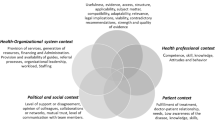Abstract
Recent changes to the patient note (PN) format of the United States Medical Licensing Examination have challenged medical schools to improve the instruction and assessment of students taking the Step-2 clinical skills examination. The purpose of this study was to gather validity evidence regarding response process and internal structure, focusing on inter-rater reliability and generalizability, to determine whether a locally-developed PN scoring rubric and scoring guidelines could yield reproducible PN scores. A randomly selected subsample of historical data (post-encounter PN from 55 of 177 medical students) was rescored by six trained faculty raters in November–December 2014. Inter-rater reliability (% exact agreement and kappa) was calculated for five standardized patient cases administered in a local graduation competency examination. Generalizability studies were conducted to examine the overall reliability. Qualitative data were collected through surveys and a rater-debriefing meeting. The overall inter-rater reliability (weighted kappa) was .79 (Documentation = .63, Differential Diagnosis = .90, Justification = .48, and Workup = .54). The majority of score variance was due to case specificity (13 %) and case-task specificity (31 %), indicating differences in student performance by case and by case-task interactions. Variance associated with raters and its interactions were modest (<5 %). Raters felt that justification was the most difficult task to score and that having case and level-specific scoring guidelines during training was most helpful for calibration. The overall inter-rater reliability indicates high level of confidence in the consistency of note scores. Designs for scoring notes may optimize reliability by balancing the number of raters and cases.

Similar content being viewed by others
References
AERA, APA, & NCME. (2014). The standards for educational and psychological testing. Washington, DC: American Educational Research Association.
Boulet, J. R., Ben-David, M. F., et al. (1998). An investigation of the sources of measurement error in the post-encounter written scores from standardized patient examinations. Advances in Health Sciences Education: Theory and Practice, 3, 89–100.
Boulet, J. R., Rebbecchi, T. A., et al. (2004). Assessing the written communication skills of medical school graduates. Advances in Health Sciences Education: Theory and Practice, 9, 47–60.
Brennan, R. L. (2001). Generalizability theory. New York, NY: Springer.
Cianciolo, A. T., Williams, R. G., et al. (2013). Biomedical knowledge, clinical cognition and diagnostic justification: A structural equation model. Medical Education, 47, 309–316.
Clauser, B. E., Harik, P., et al. (2008). The generalizability of documentation scores from the USMLE step 2 clinical skills examination. Academic Medicine, 83, S41–S44.
Downing, S. M. (2003). Validity: On meaningful interpretation of assessment data. Medical Education, 37, 830–837.
Federation of the State Medical Boards & National Board of Medical Examiners. (2015). Step 2 clinical skills (CS) content description and general information. Philadelphia, PA: United States Medical Licensing Examination. Retrieved June 25, 2015 from http://www.usmle.org/pdfs/step-2-cs/cs-info-manual.pdf
Fleiss, J. L., & Cohen, J. (1973). The equivalence of weighted kappa and the intraclass correlation coefficient as measures of reliability. Educational and Psychological Measurement, 33, 613–619.
Gilliland, W. R., La Rochelle, J., et al. (2008). Changes in clinical skills education resulting from the introduction of the USMLE step 2 clinical skills (CS) examination. Medical Teacher, 30, 325–327.
Gingerich, A., Kogan, J., et al. (2014). Seeing the ‘black box’ differently: Assessor cognition from three research perspectives. Medical Education, 48, 1055–1068.
Haist, S. A., Katsufrakis, P. J., et al. (2013). The evolution of the United States Medical Licensing Examination (USMLE): Enhancing assessment of practice-related competencies. Journal of the American Medical Association, 310, 2245–2246.
Hombo, C. M., Donoghue, J. R., et al. (2001). A simulation study of the effect of rater designs on ability estimation (ETS Research Report No. RR-01-05). Princeton, NJ: ETS. Retrieved June 25, 2015 from http://www.ets.org/research/policy_research_reports/publications/report/2001/hseq
Landis, J. R., & Koch, G. G. (1977). The measurement of observer agreement for categorical data. Biometrics, 33, 159–174.
Messick, S. (1995). Standards of validity and the validity of standards in performance assessment. Educational Measurement: Issues and Practice, 14, 5–8.
National Board of Medical Examiners. (2015). NBME 2013 Annual Report. Philadelphia, PA: NBME. Retrieved June 25, 2015 from http://www.nbme.org/PDF/Publications/2014Annual-Report.pdf
Park, Y. S., Lineberry, M., et al. (2013). Validity evidence for a patient note scoring rubric based on the new patient note format of the United States Medical Licensing Examination. Academic Medicine, 88, 1552–1557.
Southern Illinois University. (2015). DX Justification Scoring Form. Carbondale, IL: SIU School of Medicine. Retrieved June 25, 2015 from http://www.siumed.edu/oec/CCX_ASSESSMENTS/2015/DX%20Justification_scoring%20form.pdf
United States Medical Licensing Examination. (2015). 2014 Performance Data: Step 2 CS. Philadelphia, PA: NBME. Retrieved June 25, 2015, from http://www.usmle.org/performance-data/default.aspx#2014_step-2-cs
Whelan, G. P. (1999). Educational commission for foreign medical graduates: Clinical skills assessment prototype. Medical Teacher, 21, 156–160.
Williams, R. G., Klamen, D. A., et al. (2003). Special Article: Social and environmental sources of bias in clinical performance ratings. Teaching and Learning in Medicine, 15, 270–292.
Williams, R. G., Klamen, D. L., et al. (2014). Variations in senior medical student diagnostic justification ability. Academic Medicine, 89, 790–798.
Yudkowsky, R., Park, Y. S., et al. (2015). Characteristics and implications of diagnostic justification scores based on the new patient note format of the USMLE Step 2 CS exam. Academic Medicine, 90, S56–S62.
Acknowledgments
The authors thank the following faculty raters who participated in rescoring the patient notes for this study: Ananya Gangopadhyaya, MD, Nimmi Rajagopal, MD, Olga Garcia-Bedoya, MD, Alexandra Van Meter, MD, and Asra Khan, MD. The authors also thank Robert Kiser for creating an online scoring system to compile rater scores.
Author information
Authors and Affiliations
Corresponding author
Ethics declarations
Conflict of interest
None.
Ethical standards
This study was approved by the institutional review board of the University of Illinois at Chicago.
Rights and permissions
About this article
Cite this article
Park, Y.S., Hyderi, A., Bordage, G. et al. Inter-rater reliability and generalizability of patient note scores using a scoring rubric based on the USMLE Step-2 CS format. Adv in Health Sci Educ 21, 761–773 (2016). https://doi.org/10.1007/s10459-015-9664-3
Received:
Accepted:
Published:
Issue Date:
DOI: https://doi.org/10.1007/s10459-015-9664-3




